Archive for the ‘Hatsukaichi’ Category
Wednesday, August 2: After visiting the O-torii Gate at Itsukushima Shinto Shrine at somewhat low tide, I take a break to walk uphill toward Daishō-in, a historic Japanese temple complex on Mount Misen, the holy mountain on Miyajima. Including Mt. Misen, Daishō-in is within the World Heritage area of Itsukushima Shrine.
Mt. Misen sits in the middle of Miyajima Island. The mountain was opened as an ascetic holy mountain site by Kobo Daishi in the autumn of 806 when he underwent ascetic practice for 100 days in the mountain. The fire lit by Kobo Daishi is said to have been burning for 1200 years. The fire was used to light the Flame of Peace in the Hiroshima Peace Memorial Park.
Daishō-in Temple is one of the most prestigious Shingon Temples in the western part of Japan. The Shingon, or “True Word,” branch of esoteric Buddhism, was introduced to Japan from China in the 9th century. Shingon involves trying to reach the eternal wisdom of the Buddha that wasn’t expressed in his public teaching. The sect believes that this wisdom may be realized through rituals using body, speech, and mind, such as the use of symbolic gestures (mudras), mystical syllables (dharani), and mental concentration (yoga). The whole is intended to arouse a sense of the pervading spiritual presence of the Buddha that resides in all living things, according to Encyclopedia Britannica: Shingon.
In the 12th century, Emperor Toba founded his prayer hall in Daishō-in. The temple had close links with the Imperial Family until the 19th century. Emperor Meiji stayed in the temple in 1885 (Welcome to Miyajima: Daishō-in).
Though I love the bright vermilion of many Japanese temples, I have a fondness for the wooden structures that look ancient and weathered and seem to blend in with nature.
The Niomon Gate serves as the official gateway into the temple. A pair of guardian king statues stand by the gate. Nio kings are believed to ward off evil, and are determined to preserve Buddhist philosophy on earth.
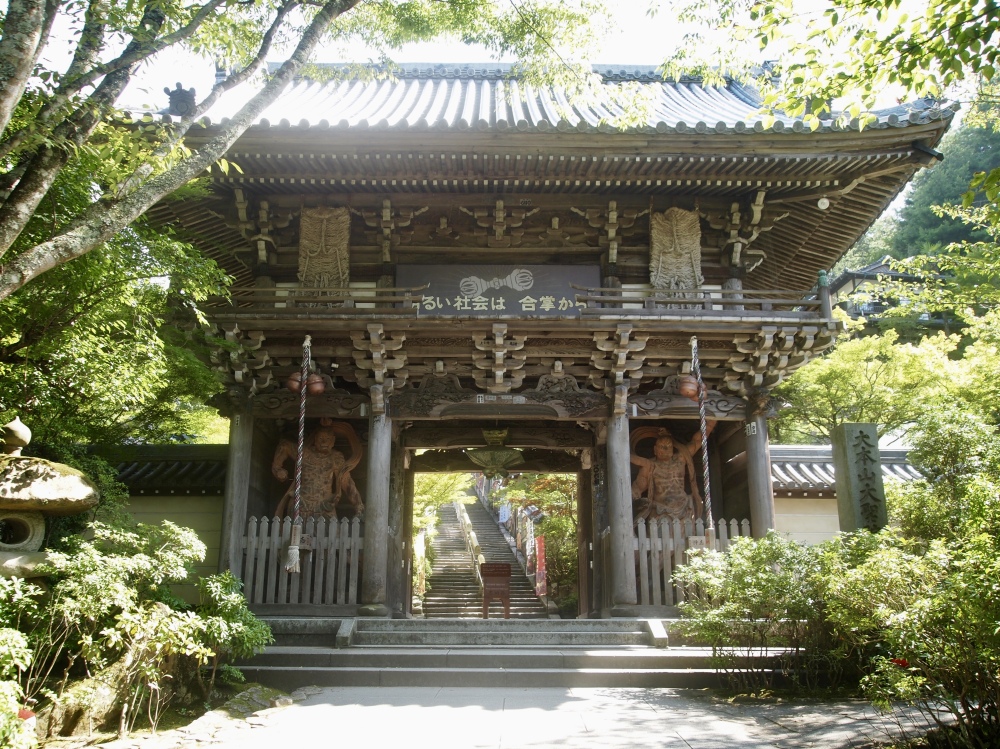
Niomon Gate of Daishō-in
Kukai, posthumously known as Kobo Daishi, is the founder of the Shingon sect. In 804, at age 31, he went to Tang, China, where he mastered profound esoteric teachings. He is also well-known as one of the three greatest calligraphers in Japan.

Niomon Gate

lantern at Daishō-in
Lining the steps to the temple are the statues of 500 Rakan statues. These represent Shaka Nyorai’s disciples. These images all have unique facial expressions. Besides the Rakan statues listed on the map below, there are other statues spread sporadically throughout the temple complex.

map of Rakan statues at Daishō-in

Rakan statues at Daishō-in

Rakan statues at Daishō-in

Rakan statues at Daishō-in

Rakan statues at Daishō-in

Rakan statues at Daishō-in

Rakan statues at Daishō-in

Rakan statues at Daishō-in

Rakan statues at Daishō-in

Rakan statues at Daishō-in

Rakan statues at Daishō-in

Rakan statues at Daishō-in

Rakan statues at Daishō-in

Rakan statues at Daishō-in

Rakan statues at Daishō-in

Rakan statues at Daishō-in
There are so many interesting things to see at this temple complex, even if I don’t know what many of them are.

water pavilion at Daishō-in

Daishō-in
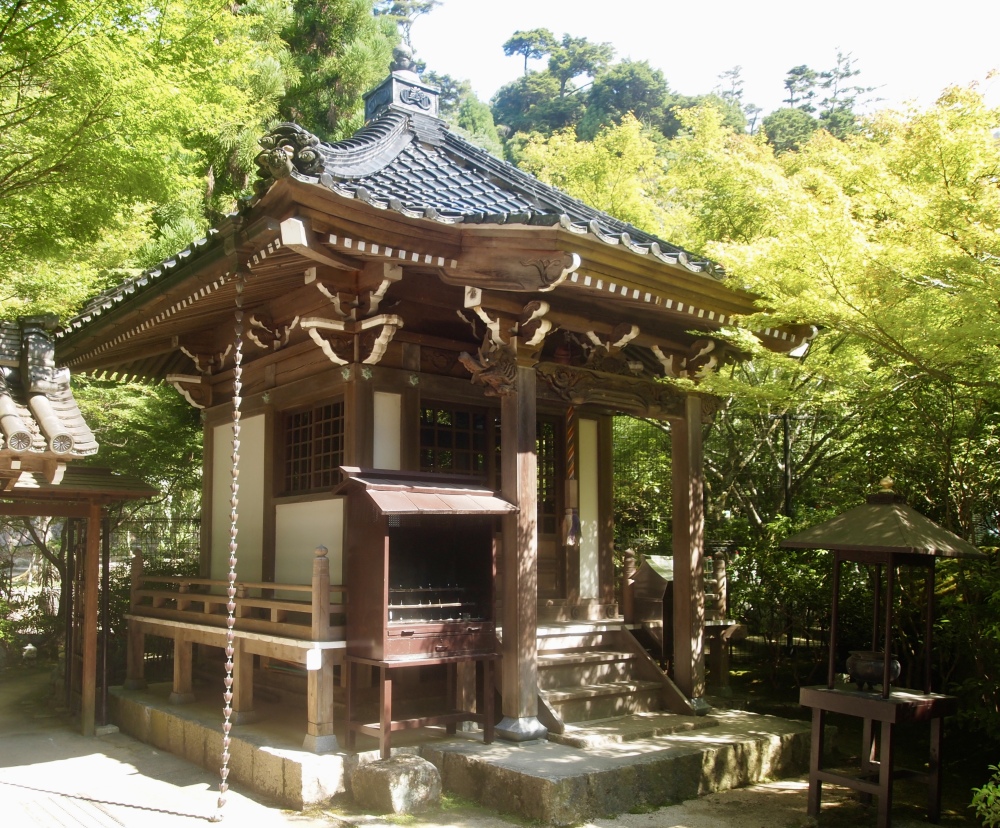
Shimo Daishi-do Hall at Daishō-in
Along the temple steps is a row of spinning metal wheels that are inscribed with sutra (Buddhist scriptures). Turning the inscriptions as one walks up is believed to have the same effect as reading them. So, without any knowledge of Japanese, a visitor can be blessed with enormous fortune by turning the wheels (japan-guide.com: Daishō-in).

stairs and prayer wheels
The bell in the belfry was once rung to tell the time in the morning, afternoon and evening in the past. Now it is rung to start the time for worship.

Belfry
Kannon-do Hall was established to enshrine the image of Kannon Bosatsu, the Deity of Mercy.

Kannon-do Hall

Kannon-do Hall

ceiling at Kannon-do Hall

treasures in Kannon-do Hall

treasures in Kannon-do Hall
A mandala using colored sand depicts the divine figure of Kannon Bosatsu, the symbol of mercy. The mandala was made by Buddhist priests from Tibet.

Kannon-do Hall
Bosatsu, or Bodhisattvas, are the ones who are undergoing ascetic training to attain enlightenment; they are committed to NOT becoming Nyorai (the highest deities of Buddhism who have attained enlightenment) unless all sufferers on earth are saved. To show their determination, Bosatsu images hold various objects.

Kannon-do Hall

ship at Kannon-do Hall

character at Daishō-in

figure at Daishō-in

figure at Daishō-in

figure at Daishō-in

figure at Daishō-in

figure at Daishō-in

ema at Daishō-in

ema at Daishō-in

ema at Daishō-in

figure at Daishō-in

figure at Daishō-in
Maniden Hall is the main prayer hall where Sanki Daigongen, or the Three Awesome Deities of Mt. Misen, are enshrined.

steps to Maniden Hall

Maniden Hall

object at Maniden Hall

Maniden Hall

Maniden Hall

Maniden Hall
Worshipers pray at Maniden Hall for good health, longevity, and contentment in their daily lives.

Maniden Hall

figures at Daishō-in

Daishō-in
Commemorating the current (77th) head priest’s succession, 1,000 Fudo myo-o, or Immovable King, images were donated by worshipers.

one thousand Fudo myo-o, or Immovable King, images

figures at Daishō-in
In the dimly lit Henjokutsu Cave are the sand and the principal Buddhist icons of the 88 temples of the prestigious pilgrimage route on Shikoku. Worshipers believe that they are given the same blessings as people who make the pilgrimage to all the temples on the route (Welcome to Miyajima: Daishō-in).
It is my dream to one day do the Pilgrimage to the 88 Sacred Places of Shikoku.

representations of 88 temples of Shikoku in Henjokutsu Cave

pond at Daishō-in

figure at Daishō-in
After leaving Daishō-in, I visit Itsukushima Shinto Shrine and the O-torii Gate once again, as I make my way back to the ferry. This time the tide is higher (miyajima: itsukushima-jinja & the floating o-torii gate). Then I return by ferry and train to Hiroshima. At my hotel, I ask for a recommendation for a good okonomiyaki restaurant. Hiroshima is famous for oysters and okonomiyaki (savory pancakes: batter, cabbage, vegetables and seafood or meat cooked on a griddle). The local version, Hiroshima-yaki, features individual layers, and noodles as the key ingredient (Lonely Planet Japan).
The place recommended by the hotel is open air with no air-conditioning. It is much too hot for me to eat in there. I’ve been sweating all day and look forward to cooling off during dinner. So I walk back up the same street and find the perfect (air-conditioned) restaurant.

diner for Hiroshima-yaki
Here I’m greeted by a very friendly waitress who speaks some English. A baseball game is on the TV in the background, and she keeps cheering for the Hiroshima Toyo Carp, the local baseball team.

diner for Hiroshima-yaki
It’s quite a process watching the chef whip up the Hiroshima-yaki. I’m able to order mine with just shrimp. I never want squid in these pancakes, even though squid seems to be the most common ingredient.
I have to say this pancake is one of the most delectable things I’ve eaten in Japan. Even though it’s huge, and filling, I have to eat every last bite. 🙂

cooking Hiroshima-yaki

Hiroshima-yaki

Hiroshima-yaki

baseball at the local diner

Hiroshima-yaki

Hiroshima-yaki

Hiroshima-yaki
After dinner, I stroll along the river in Hiroshima.

a pretty restaurant along the river

twinkling lights

riverside restaurant
I see one last view of the Hiroshima A-bomb dome.

Hiroshima A-bomb dome
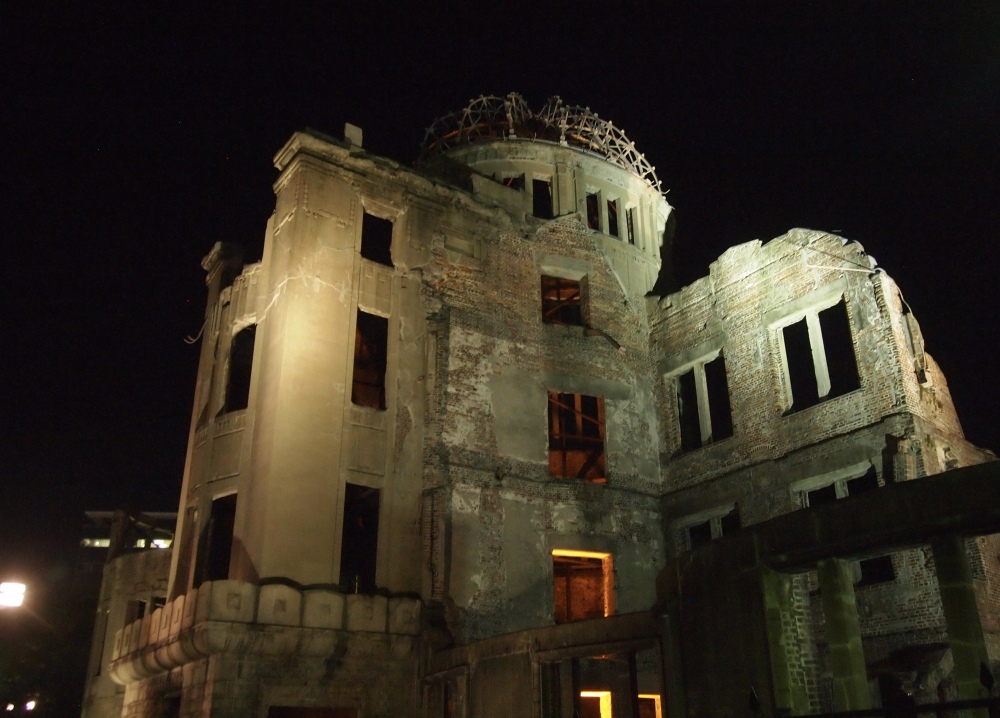
Hiroshima A-bomb dome

paper cranes for peace
Tomorrow morning, I’ll leave for Nara, where I’ll spend two nights. 🙂
Total steps today: 21,442 (9.09 miles)
Wednesday, August 2: After leaving Senjo-kaku Pavilion, I make my way down to the water to see the “floating” O-torii Gate of Itsukushima Shrine.
In December of 1996, the World Heritage Committee official designated Itsukushima Shinto Shrine as a World Cultural Heritage site. The area includes 431.2 hectares including the building of Itsukushima Shrine, the sea to the front, and the Mt. Misen Primeval Forest (Natural Treasure) to the rear. This wide area covers nearly 14% of Miyajima Island.
The O-torii Gate of Itsukushima Shrine is designated as a National Important Cultural Property. It is about 16.6 meters tall and weighs about 60 tons. Its roof, thatched with Japanese cypress bark, is 24.2 meters long. The main pillars, 9.9 meters in circumference, are made of natural camphor trees, while the four supporting pillars are made of natural cedar. The present O-torii, which is the 8th since the Heian period, was erected in 1875. The top rail of the torii has a hollow space, and stones the size of one’s fist are put inside as a weight (7 tons in all). The gate stands under its own weight.
When I reach the shrine, it’s 2:20 p.m., still quite a long time until high tide at 6:42 p.m. At least it’s not low tide (which was 11:46 a.m.), when it is the least scenic, sitting as it does in the muddy sand at low tide. Because the tide is still somewhat low, people are wading around by the gate.

first glimpse of the O-torii Gate at Itsukushima-jinja
The Miyajima deer are relaxing in the shade, a smart move as it’s in about 95 degrees F (around 35C) and very humid.

deer in Miyajima
Itsukushima Shrine is dedicated to the three Munakata goddesses, Ichikishima-hime, Tagitsu-hime and Tagori-hime. These three goddesses are worshiped as deities of sea, traffic safety, fortune and accomplishment.
As I join the people wading near the O-torii Gate, I can see on the shore the shrine sitting on stilts in the sand. The water will reach the shrine at sunset, during high tide at 6:42 p.m.

Itsukushima Shrine
I wade out to the O-torii Gate, enjoying the lapping of the slightly cool water on my feet and calves.

O-Torii Gate 2
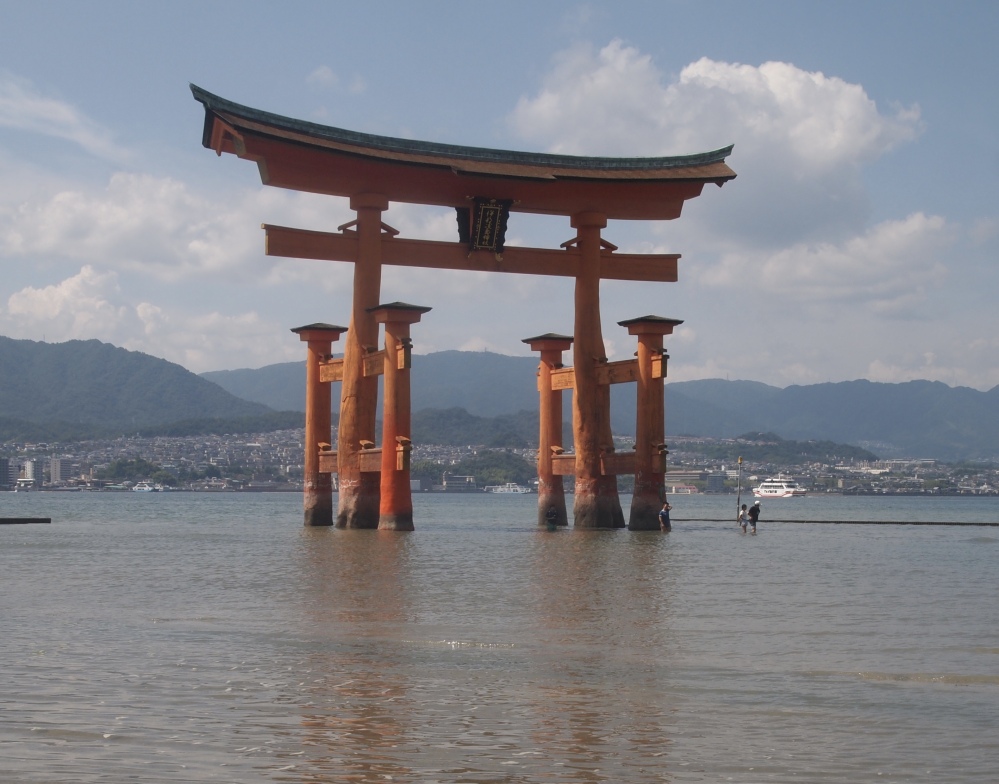
O-Torii Gate 3
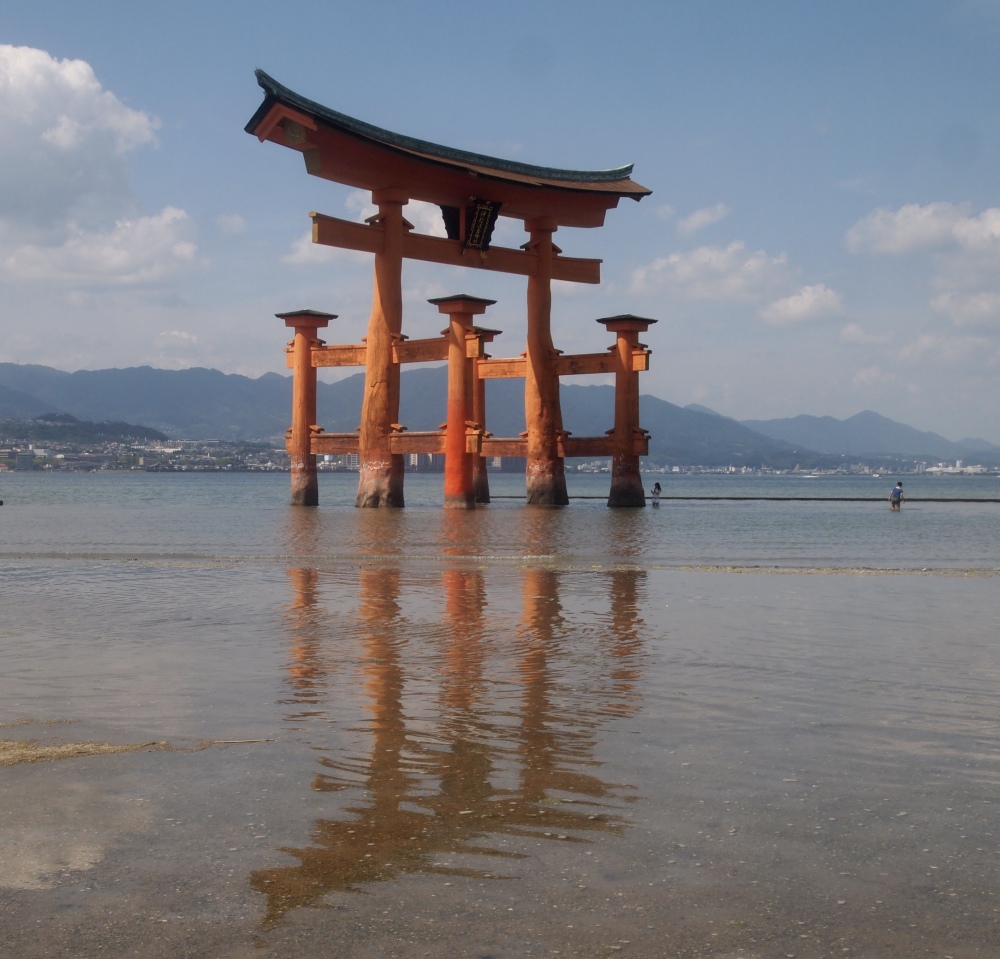
O-Torii Gate 5

O-Torii Gate 6
I make my way through the water to the opposite shore.
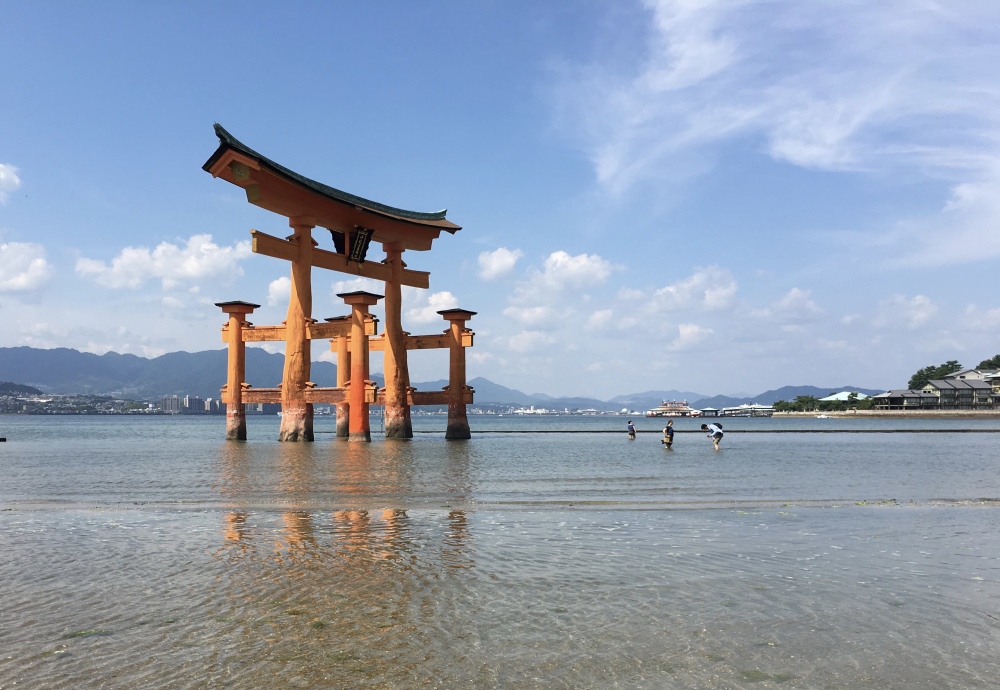
O-Torii Gate 10

O-Torii Gate 11
The map below shows my route so far. I came from the ferry on the bottom left of the map, walked along Omotesando Shopping Arcade, went up to the Five Story Pagoda and Senjo-kaku Pavilion, and then made my way down to the O-torii Gate. I know there are more temples to see in the hills to the right, so, I head in that direction. I walk through Daigani Temple and then walk uphill to Daishoin Temple. I will go through Itsukushima Shrine after visiting these shrines so it will be closer to high tide.
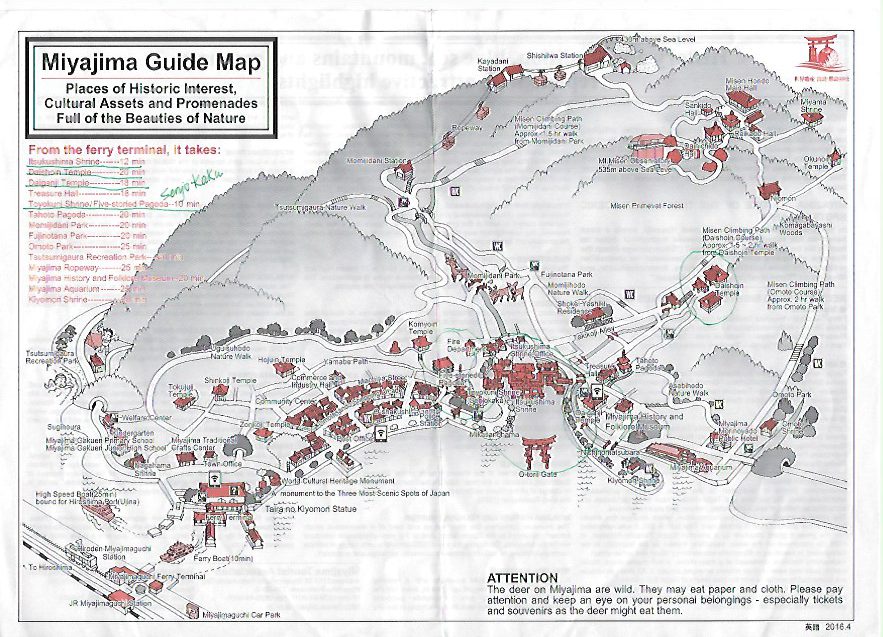
Miyajima Guide Map
I walk briefly through Daiganji Temple, which until the Meiji Restoration (1868), was in charge of the repair and construction of the Itsukushima Shrine. It is dedicated to Benzaiten, the Goddess of eloquence, music, wisdom and wealth. The statue below is a wood carving, but I’m not sure of whom.

figure at Daiganji Temple
You can read more about Daiganji Temple here.
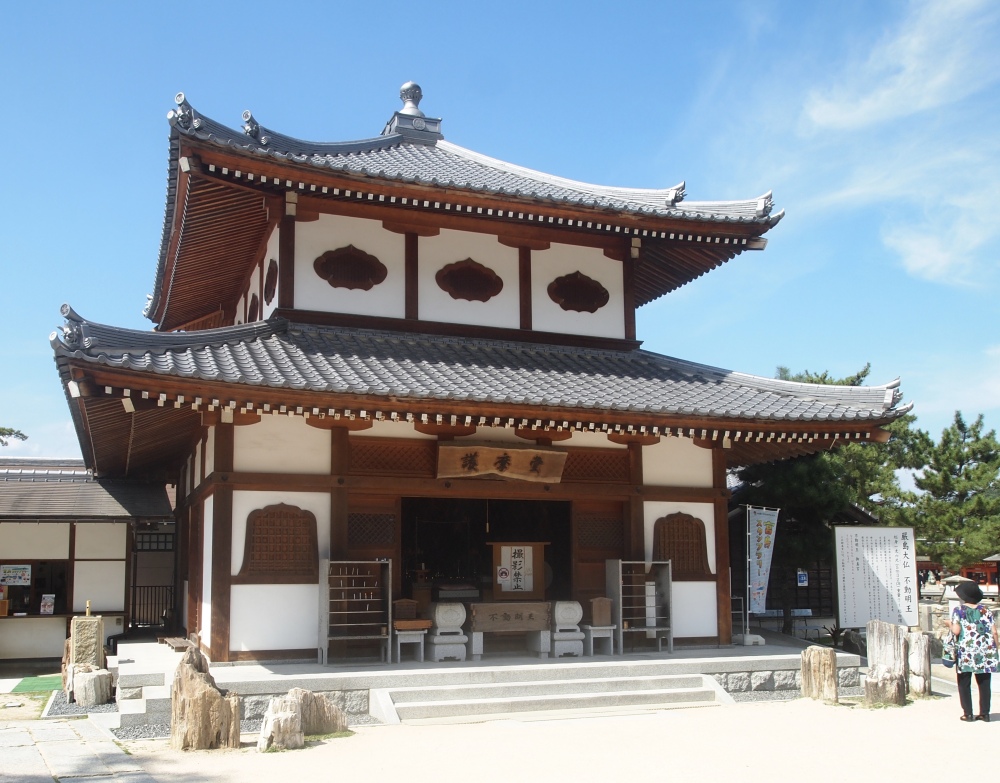
Daiganji Temple
On the way to the path to Daishoin, I pass the Benzaiten statue and Itsukushima Shrine before heading uphill.
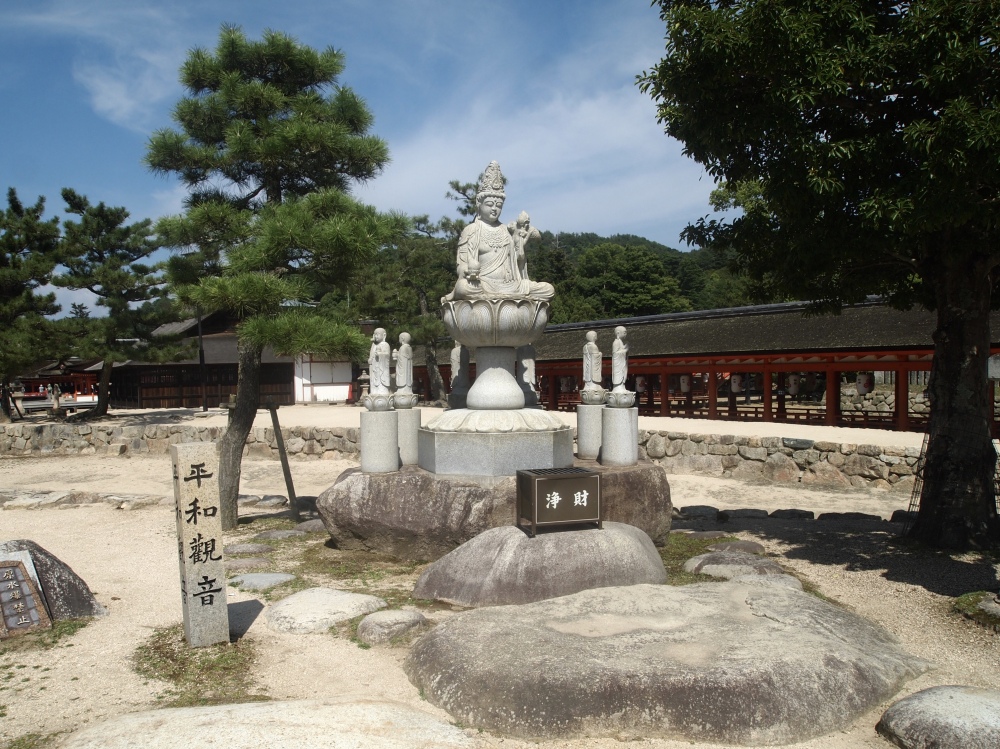
Buddha figure with Itsukushima Shrine in the background
I also walk past the Miyajima History and Folklore Museum, but I don’t go in. The museum preserves the main house and part of a storehouse which formerly belonged to the Egami family, one of the most prosperous merchant families in Miyajima. On display are about 1,000 items of a wide range of Miyajima folklore materials, including ancient documents, paintings and woodcraft.

Miyajima History and Folklore Museum
I head uphill to Daishoin Temple, where I spend nearly an hour. In the interest of keeping everything about Itsukushima Shrine in one blog post, I’ll write about Daishoin in another post.
I leave the Miyajima History and Folklore Museum at nearly 3:00, and, after visiting Daishoin, by 4:00, I’m back down to the Itsukushima Shrine. I have to walk all the way around to the other side to get into the shrine through the entrance.

Itsukushima Shrine

deer near Itsukushima Shrine
Finally, I’m in the pavilion walkways of Itsukushima Shrine. It’s the perfect beach shrine, with its open-air walkways.

Itsukushima Shrine
Though it’s now after 4:00, only an hour and a half from high tide, the water has still not reached the shrine, although some rippling pools of water are making their way up slowly.

Itsukushima Shrine 2
I love the lanterns swinging in a slight breeze in the pavilions.
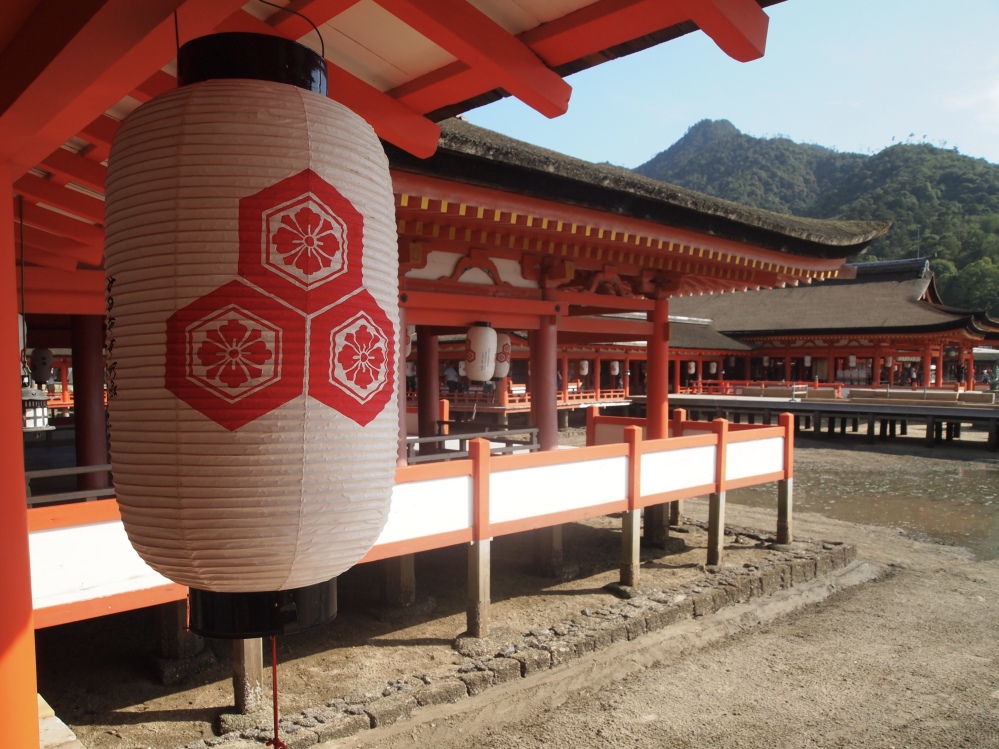
Itsukushima Shrine
The shrine is known for its unique construction, displaying the artistic beauty of the Shinden style of architecture. First built in 593, it was remodeled into the present grand structure by a powerful figure, Taira-no-Kiyomori, in 1168. Its placement on the water, beautifully framed by the mountain in the background, is testimony to Kiyomori’s extraordinary vision and achievement.

Itsukushima Shrine
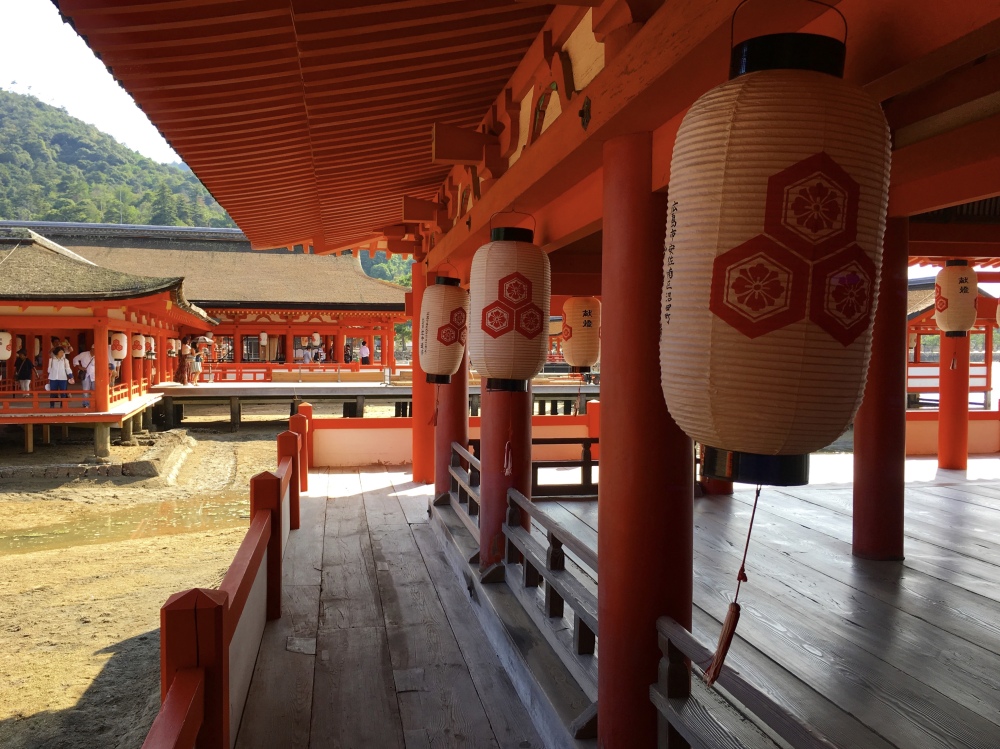
lanterns at Itsukushima Shrine
Itsukushima Shrine is composed of a main shrine, a Noh drama stage, music rooms, halls and several other shrines arranged around it. All these structures are connected by corridors with a total length of about 300 meters.
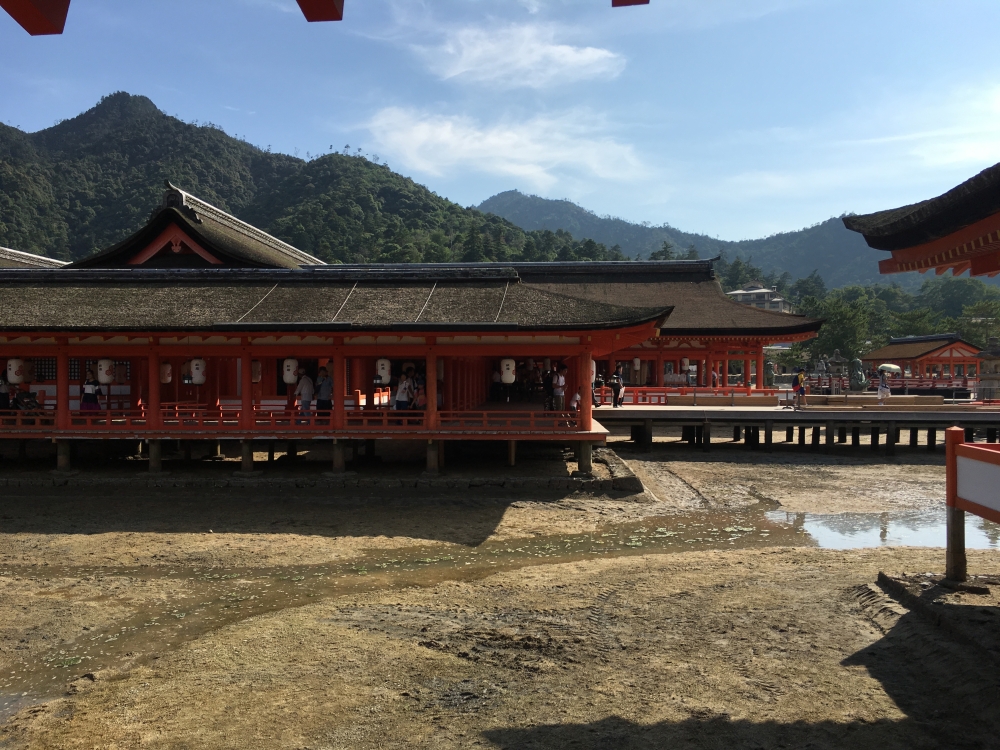
Itsukushima Shrine at low tide

Itsukushima Shrine with the Five Story Pagoda behind

Itsukushima Shrine

Itsukushima Shrine

The O-torii Gate as seen from Itsukushima Shrine

Itsukushima Shrine

Itsukushima Shrine

Itsukushima Shrine

Itsukushima Shrine

sake barrels at Itsukushima Shrine

bridge at Itsukushima Shrine

Itsukushima Shrine
After leaving the shrine, I can see O-torii Gate at Itsukushima Shrine. It’s now about 4:20. Now the water is too deep for waders, so no one is in the water.

O-Torii Gate at higher tide

O-Torii Gate at higher tide

O-Torii Gate at higher tide

Itsukushima Shrine

ema at Itsukushima Shrine
The vermilion color of the shrine and of the O-torii is considered to keep evil spirits away. The shrine buildings are coated with vermilion lacquer, which is also efficient as protection from corrosion.

Itsukushima Shrine

Itsukushima Shrine
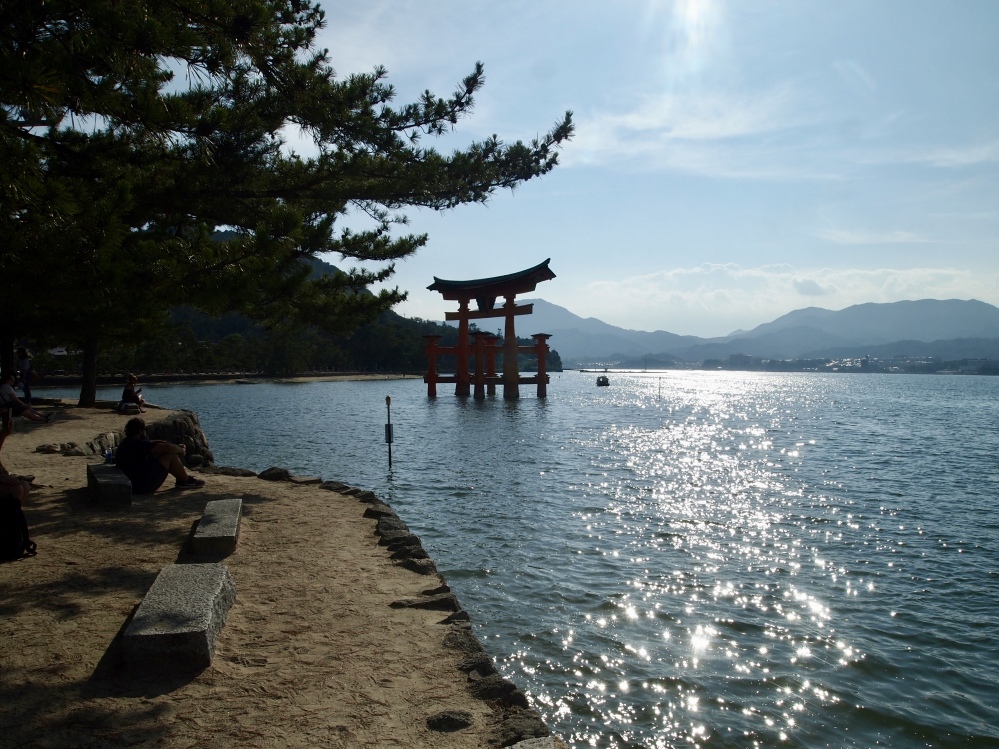
last view of the O-torii Gate
I have my last view of the O-torii gate at 4:30 p.m. If I could only stay two more hours, I’d see the shrine covered at high tide, but I’m worried about catching the ferry back to Hiroshima, where my hotel is. It’s a shame I didn’t spend the night here.
It’s quite a long haul back to Hiroshima, first on a different ferry, larger than the one I took to get here, and then a long train ride back to Hiroshima. In Hiroshima, I look forward to sampling Hiroshima’s famous dish: okonomiyaki, similar to Osaka’s but with noodles.
Wednesday, August 2: From the Motoyasu Bridge Pier bordering Peace Memorial Park in Hiroshima, I take a 50-minute ferry ride to the island of Miyajima for 2,000 yen (~$18). The ride is quite pretty, with islands jutting up in green mounds out of the choppy Hiroshima Bay.

Hiroshima Bay from the ferry
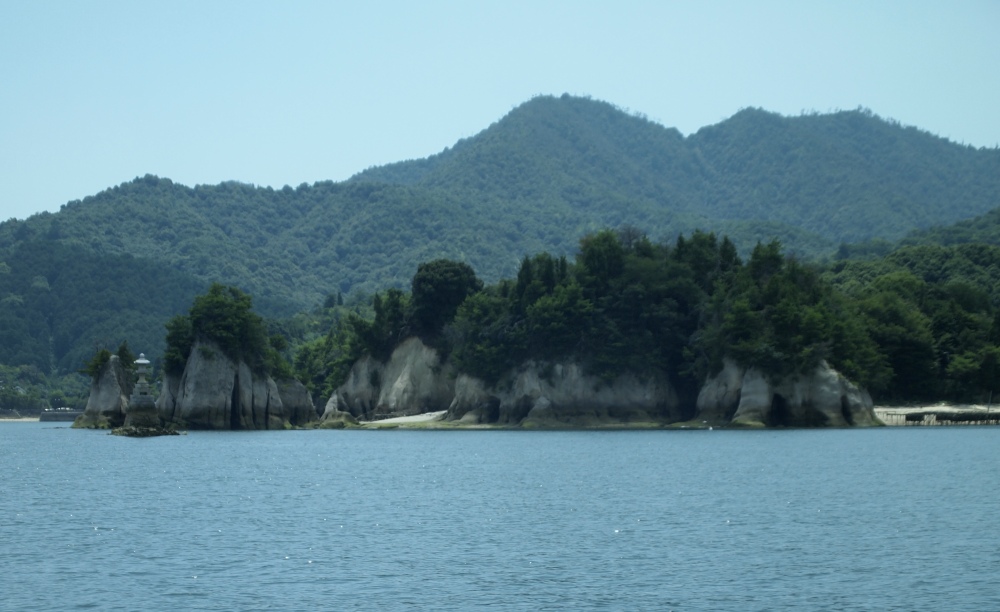
on the way to Miyajima

Hiroshima Bay from the ferry

Boat from Motoyasu Bridge Pier to Miyajima
I checked the tidal information before I came, as it’s recommended to come around high tide to see the best view of the O-torii Gate at Itsukushima Shrine. I’ve arrived at the island at 12:47 pm, and high tide isn’t until 18:42, slightly less than 6 hours from my arrival time. I know there is no way I will stay that late as I must return by ferry to Hiroshima. Maybe I will be able to see the tide rise high enough during the day to get some decent photos of the famous floating torii.
I had read you could rent bicycles on Miyajima, but I’m told by someone at Tourist Information that it’s impossible. Apparently, the island is easily walkable, so I promptly set off on foot.
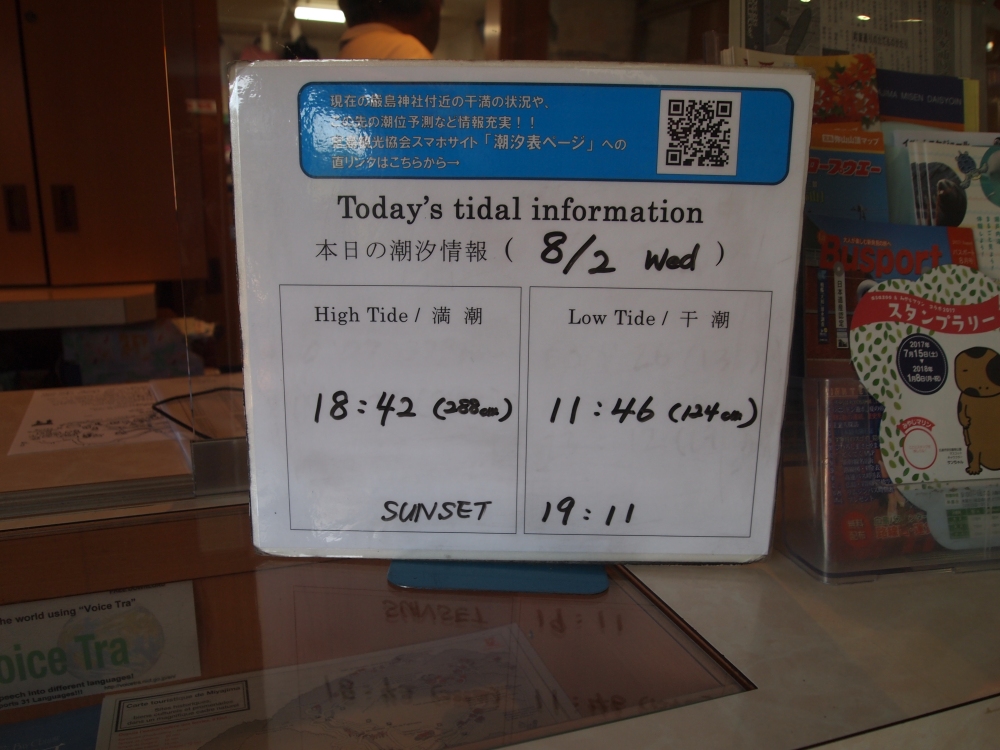
Today’s tidal information
I’ve heard all about Nara’s famous deer, but I’m surprised to find deer wandering the streets of Miyajima. The deer here are wild, but we’re warned they may eat paper and cloth, especially tickets and souvenirs.

deer in Miyajima
I walk along the main street of the town, but turn inward to enter Omotesando Shopping Arcade. As it’s after lunchtime, I’m hungry, so I keep my eye out for a restaurant. I’ve heard that Miyajima is famous for its broiled or grilled oysters, so I’d like to find some of those.

beginning of Omotesando Shopping Arcade
Some of the deer seem to be looking for dining spots as well.

shopping deer
The arcade is shaded, luckily, as it’s extremely hot and humid. I don’t know how I’m going to last very long in the heat today. At least I hope to find air conditioning in a restaurant.

Omotesando Shopping Arcade
There are so many cute things I’m tempted to buy in the shopping arcade, but buying anything means I’ll have to carry whatever it is around for the rest of my week of travels. As I only have a carry-on bag with me, and it’s already packed, I have to pass on everything.

souvenirs in Miyajima

fan

Kokeshi Dolls

socks with blossoms

cats

critter socks
I love the Japanese traditional Kokeshi Dolls, but luckily I already bought a small one at Hanazono-jinja’s flea market in Shinjuku. It’s already in a box on its way back to Virginia.

Japanese Traditional Kokeshi Dolls
I decide to eat at this restaurant graced by a smiling deer. The plastic foods on display show broiled oysters.

restaurant for grilled oysters
I enjoy my meal of Kaki-no-sugata Yaki, or broiled oysters in the shells, but I must admit the meal doesn’t fill me up. Oh well, I’m planning to eat Okonomiyaki, Hiroshima’s famous dish, tonight, so I’m okay not to eat too much. Besides, it’s too hot outdoors to walk around on a full stomach.
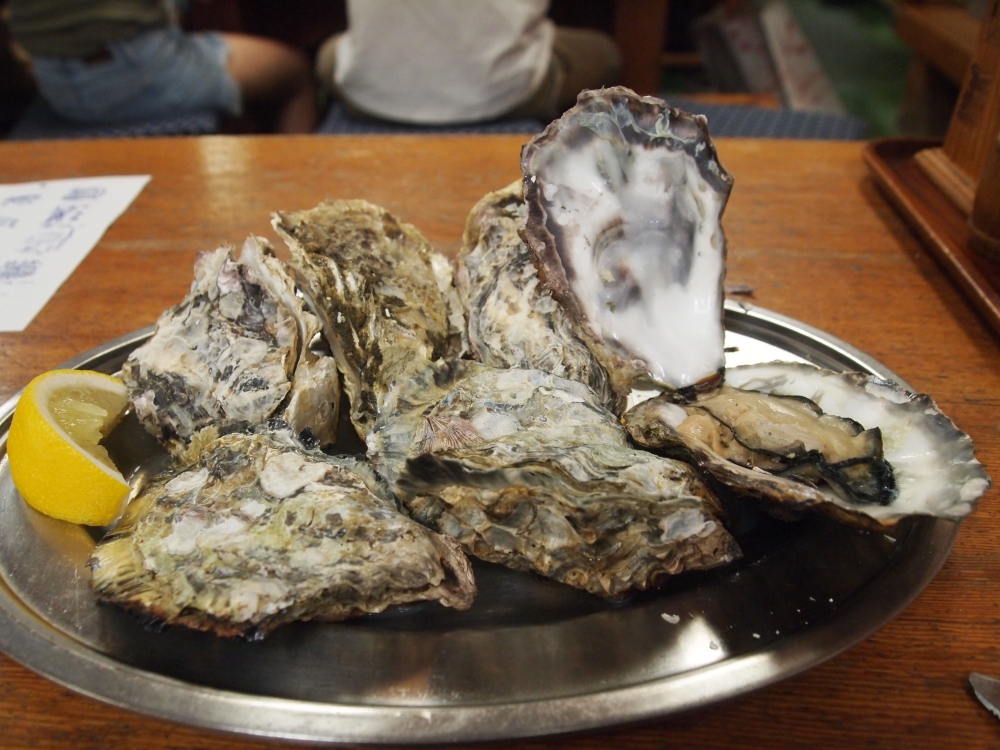
Kaki-no-sugata Yaki
I don’t really know where I’m going in this town, but I follow the road to the conspicuous Five-storied Pagoda and Senjokaku, also called Toyokuni Shrine.
The Five-storied Pagoda, built in 1407, enshrined Yakushi Nyorai Zazo, the Buddha of Medicine, as well as Fugen Bosatsu (Mercy Buddha) and Monju Bosatsu (Wisdom Buddha).
Yakushi Nyorai Zazo, the Buddha of Medicine, is said to have been made by Kūkai, also known posthumously as Kōbō-Daishi, 774–835. He was a Japanese Buddhist monk, civil servant, scholar, poet, and artist who founded the Shingon or “True Word” school of Buddhism (Wikipedia: Kūkai).

upstairs to the Five-Storied Pagoda
From the hilltop where the Five-storied Pagoda sits, I can see the mainland and the town of Hatsukaichi.

view from Senjokaku pavilion
Senjokaku (literally “Pavilion of 1000 mats”), also called Toyokuni Shrine, is the largest structure at Miyajima Island. It’s basically an open-air hall that has ancient paintings hanging from its rafters. Today many Japanese folks find respite from the searing sun on the pavilion’s cool and smooth floors.
Toyotomi Hideyoshi, a preeminent daimyō (powerful feudal lord), warrior, general, samurai, and politician of the Sengoku period, started construction of Senjokaku as a Buddhist library where people could chant Senbu-kyo sutras for fallen soldiers.
Hideyoshi is regarded as Japan’s second “great unifier,” bringing an end to the Warring States period (c. 1467 – c. 1603). He died in 1598 and the building was never fully completed. Originally, Amida Buddha and two subordinate Buddhist saints, Anan and Kasho-sonja, were enshrined in the structure until the Meiji reformation, when the structure was converted into a Shinto shrine dedicated to Toyotomi Hideyoshi.
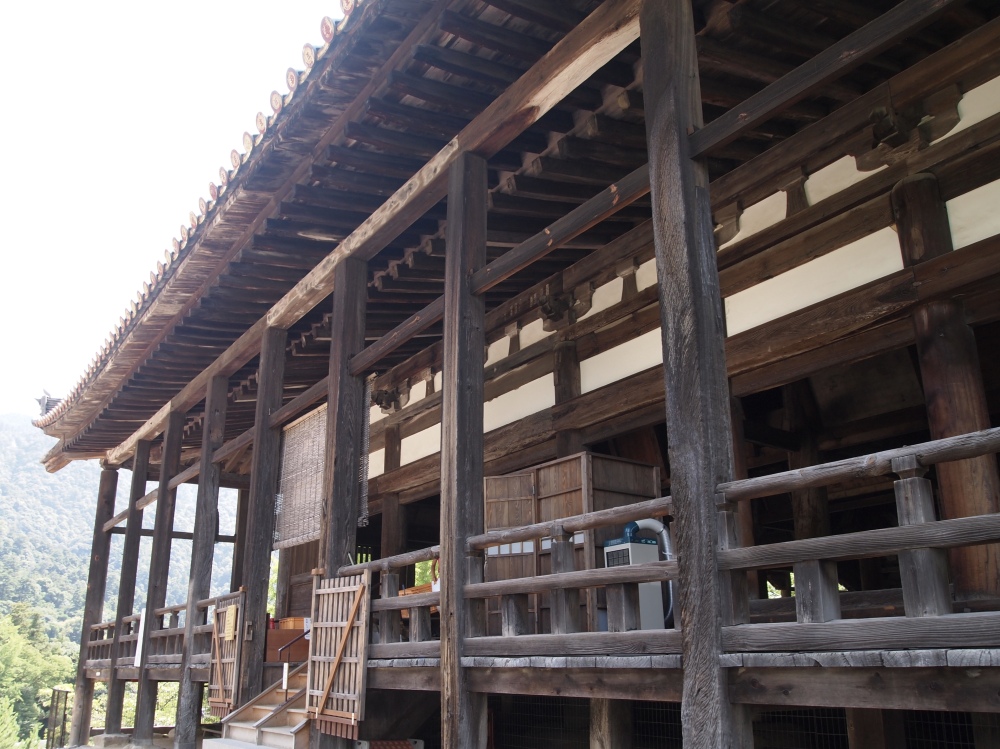
Senjo-kaku pavilion

Five-Storied Pagoda
From the hilltop, I can see some of Miyajima’s many shrines, most notably Itsukushima Shrine, home of the floating torii.

view from paintings at Senjokaku pavilion
Numerous votive picture tablets that had been hanging in the Itsukushima Shrine buildings until the Meiji era hang today on the walls inside Senjokaku.

paintings at Senjokaku pavilion

paintings at Senjokaku pavilion

Senjokaku pavilion

Senjokaku pavilion

Senjokaku pavilion

Senjokaku pavilion

Senjokaku pavilion

Senjokaku pavilion
I love the airy feel of Senjokaku pavilion. I wander around here for some time, enjoying the shaded area with a bit of a breeze whispering through. The multitudes of ancient paintings create an atmosphere heavy with history.

Senjokaku pavilion
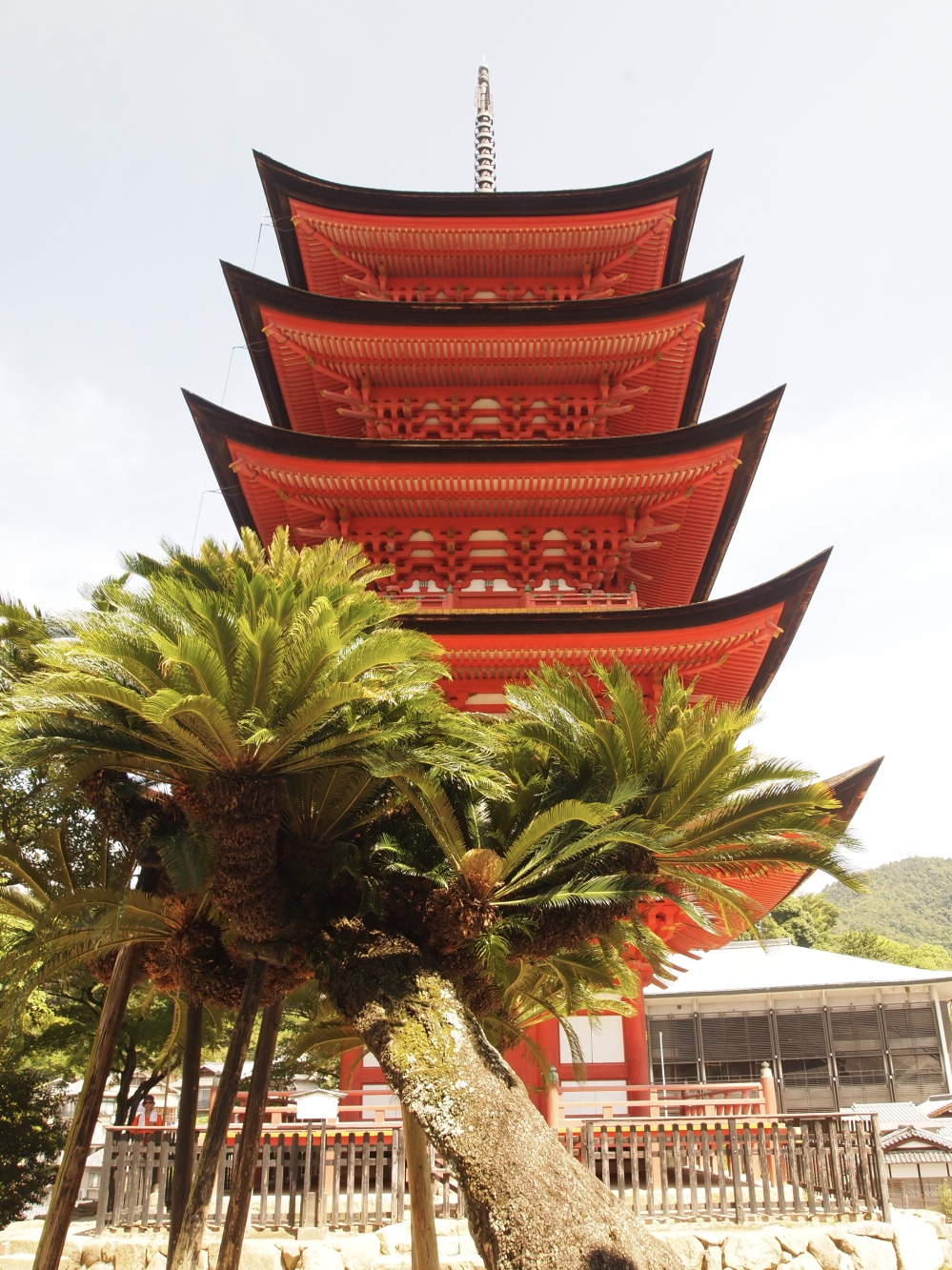
Five-Storied Pagoda
Finally, I leave the pavilion and head downhill in search of the famous O-torii Gate. On the way, I pass more friendly deer. It’s only 2:14, so the tide won’t be high enough yet to make the torii gate picturesque.

deer in Miyajima
I continue on to the beach, where I find people wading out in the water around the O-torii Gate. At least it’s not sitting in mud at this point!



















































































































































